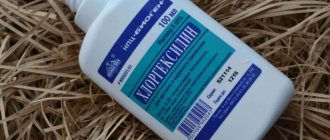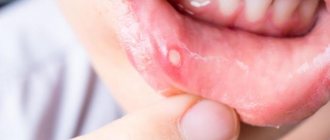≡ Home → Chamomile → Use of chamomile in medicine →
Chamomile is very famous as a sore throat remedy. Perhaps, no other organ is treated with it more often than the throat - even its most proven ability to relieve abdominal pain is used less often than gargling, although in fact the effectiveness of chamomile for abdominal pain is higher than for diseases accompanied by pain in the stomach pharynx or larynx.
The main effect of gargling with chamomile is to reduce inflammation and sore throat.
This is partly due to the fact that gargling with chamomile is almost completely safe. If a person is able to carry out such procedures and spit out the solution without swallowing, he can carry them out. Due to this safety, chamomile is often used even when there is no need for it - just in case, sometimes even for prevention, which is completely unfounded, but not harmful. However, in many cases, chamomile actually helps to relieve and even completely eliminate sore throats, which justifies its use as part of medicinal complexes for various diseases. Let's figure out when it's really worth gargling your mouth and throat with chamomile, what results you can expect from such gargles, and how to carry them out correctly.
What effect can you get from gargling with chamomile?
In the treatment of diseases accompanied by sore throat, chamomile is used primarily to relieve pain. A decoction or infusion of it with regular rinsing provides some astringent and analgesic effects, helps reduce inflammation of the tonsils and mucous membranes, which ultimately improves the patient’s well-being.
It is widely believed that chamomile is useful to take as an antibacterial agent for various diseases caused specifically by bacterial infections. However, in reality, no chamomile preparation can have a significant effect on a bacterial infection that affects, for example, the tonsils or mucous membranes of the pharynx. Therefore, for example, for sore throat or streptococcal pharyngitis, chamomile preparations can only be used as additional means of antibiotic treatment.
Throat with a typical lacunar sore throat - in this case, chamomile can only slightly ease the pain, but it will not completely remove it.
On a note
The antibacterial properties of chamomile are less pronounced than, for example, those of special pharmaceutical antiseptics - furatsilin, miramistin, chlorhexidine. For disinfecting the oral cavity and pharynx, for example, after eating, chamomile preparations are not suitable. At the same time, even such powerful agents as Miramistin or Furacilin are also not able to suppress bacterial infection in the tonsils or in the tissues of the pharynx, therefore, for the corresponding diseases, they are also used only as auxiliary agents. Simply put, to prevent, for example, caries, it is better to rinse your mouth with special pharmaceutical solutions, and chamomile is more suitable for sore throats.
In addition to soothing a sore throat, chamomile has a similar effect on almost any tissue it comes into contact with when applied. For example, you can rinse your mouth with it to relieve pain in the gums or palate, which is important for stomatitis. Sometimes it is even recommended as a means to relieve toothache, but here its capabilities are very limited - a decoction with it cannot penetrate into the inflamed pulp or periodontal tissues and therefore the active substances of such a drug act only on the surrounding tissues. The effect is weak.
A swollen cheek with advanced pulpitis - in this case, chamomile decoction will definitely not help.
Chamomile preparations also provide the standard moisturizing and cleansing effects for liquid products. With proper rinsing, some of the mucus comes off and food debris, which is a source of nutrition for many pathogenic and opportunistic microorganisms, is washed away. Although for this purpose, the throat can be no less successfully gargled with plain salted water, a solution of soda or, for example, decoctions of other remedies - calendula, sage, oak bark. All of them perform the cleansing function with the same efficiency.
Folk recipes
Over the millennia, people have learned to use chamomile in many different ways.
- For dry and sore throat, brew a tablespoon of herb in a glass of water and add a teaspoon of honey.
- If your sore throat persists, combine chamomile with oak bark, sage, eucalyptus and other extracts.
- Inhalations have a powerful effect. Brew two tablespoons of chamomile in 500 ml of water and breathe in the steam from the solution for 15 minutes. Bend over the vessel and throw a blanket or thick cloth over your head to prevent the steam from escaping. Inhalations are prohibited for purulent sore throat!
- Do foot baths - they also affect the immune system and can help with a sore throat.
- Make a healing oil. Fill a glass jar to the top with herbs and add oil. After the composition has infused for several days, strain off the oil. Then lubricate the sore throat and tonsils with the product, after mixing it with regular vegetable oil in a 1:1 ratio.
- If your throat hurts due to a fungal disease, add a little boric acid to the gargling broth.
- To lose weight, mix a teaspoon of crushed strawberry leaves, St. John's wort, chamomile and birch buds. Pour the finished mixture with 2 cups of boiling water. After 12 hours it can be taken 100 grams twice a day. The decoction accelerates the removal of harmful substances from the body and optimizes salt metabolism.
- For cystitis, mix chamomile with St. John's wort, knotweed, corn silk and cornflower. Pour 400 ml of boiling water over them, strain after an hour. You need to drink immediately after eating.
Other recipes involve brewing chamomile tea. The herb can be combined with mint and lemon balm.
How popular and important are such procedures and when should they be carried out?
It is important to understand that for a sore throat, chamomile will not quickly cure the disease. It has only a limited symptomatic effect, that is, it affects only some manifestations of the disease - pain, inflammation - but not the cause itself. Therefore, you should not expect that with the start of rinsing with chamomile, the disease will immediately end - most likely, it will last as long as it would have lasted without rinsing, the patient will simply tolerate it more easily.
Further, the main medicinal effects of chamomile are not absolute. For example, if it is very painful to swallow during an illness, rinsing will not completely get rid of this pain, and the procedures themselves can only ease the pain syndrome and contribute to a faster completion of it in the final stage of the disease.
Likewise, chamomile tea or decoction is not able to completely relieve inflammation in the throat. It will weaken a little with proper rinsing, but will completely disappear only after the infection is eliminated.
Throat with herpetic sore throat, when all the red papules hurt very much and this pain is almost impossible to completely relieve with chamomile.
Finally, the effect of chamomile when gargling is limited only to the throat. This means that the greatest benefit of its drugs is manifested when:
- Tonsillitis;
- Pharyngitis;
- Laryngitis with localized pain in the upper parts of the throat;
- Stomatitis with the spread of rashes to areas of the palate in the peripharyngeal ring - in this case the pharynx hurts, but for the patient the syndrome feels localized precisely in the throat.
For all these diseases, rinsing can effectively treat inflamed tissues.
At the same time, gargling a sore throat with chamomile preparations is ineffective if the solution itself cannot reach the area of inflammation. So, chamomile practically does not help or has a very weak effect with the following diseases and syndromes:
- Tracheitis - it is physically impossible to gargle so that the solution is in the trachea;
- ARVI - with them, inflammation is localized in the nasal passages or in the upper respiratory tract, which are not treated during rinsing, and the effect of rinsing is much less pronounced and is limited only to moisturizing and cleansing the surfaces of the mucous membranes. If you have a sore throat during ARVI, rinsing with chamomile will ease the pain here, but will have virtually no effect on other symptoms;
- A typical cold, or acute rhinitis - for the same reason as with ARVI: here the focus of inflammation is in the nasal cavities;
- For cough caused by bronchitis or pneumonia. When gargling, it is impossible to “reach” the solution into the lower respiratory tract and chamomile will not have an effect on inflamed tissues.
For coughs, chamomile is generally of little use, since it acts only locally, and it is almost impossible to apply it to inflamed tissues due to bronchitis or pneumonia.
Also, chamomile is practically useless for the prevention of throat diseases. Rinsing with it does not have any protective effect.
Likewise, there is no point in drinking chamomile to treat a throat. When used this way, it has virtually no effect on the inflamed tissues of the pharynx and does not affect the severity of symptoms. However, it is when taken orally that its side effects are most likely. Therefore, by the way, there is no need to give chamomile to a newborn or an infant if he has a red throat - the chamomile preparation will not affect the condition of the throat itself, but it is quite capable of causing diarrhea (very dangerous for a child in the first year of life).
We draw an intermediate conclusion: chamomile can be used for sore throats as an additional remedy, which, with proper treatment, will help to relieve pain and inflammation to some extent. It will not completely cure the disease, but it can alleviate the patient’s condition.
It is important to understand that treating a throat with chamomile is not always completely safe, and in some cases it should be abandoned altogether.
Indications
Chamomile treatments are required for a large list of ENT diseases. Due to its strong antiphlogistic effect, it is recommended to be used for:
- tonsillitis;
- laryngitis;
- scarlet fever;
- sore throat;
- pharyngitis;
- stomatitis;
- inflammation of the gums.
The product reduces the occurrence of toothache, and also disinfects the oral cavity and removes swelling and inflammation.
Safety of procedures and remedies with chamomile for the throat
Gargling, as the most common way to treat a throat with chamomile, is also the safest. If a person can gargle so that the solution does not enter the respiratory tract, he can carry out such procedures - they almost never cause side effects. This is due to the fact that when rinsing, no components of the chamomile preparation enter the bloodstream and do not have a systemic effect on the body - the product acts only locally.
It is also useful to read: The benefits and harms of chamomile
Exceptions are the following cases:
- Allergy to chamomile, other types of chamomile or other flowers of the aster family, including ragweed. If a patient with such hypersensitivity begins to gargle with chamomile decoction, he is likely to develop an allergy, which will aggravate his condition;
- Throat diseases in children under 5 years of age, primarily in newborns and infants. A child at this age does not know how to gargle and is likely to either swallow the solution (which can cause diarrhea) or simply spit it out. In neither case will the benefits of chamomile appear. However, in a small child, the chamomile preparation may enter the respiratory tract, which can lead to lung damage. To avoid such accidents, you should not give chamomile to children 2-3 years old, and even more so to newborn babies or infants under one year old.
Separately, it is necessary to say about the chamomile throat compress. Staging it belongs to the so-called “distracting” procedures and, depending on the cause of the disease, can be either very dangerous or, at best, useless. For example, in case of a bacterial infection, a compress is strictly prohibited, since it helps to warm up the site of inflammation and activate the infection itself (bacteria multiply the faster the higher the tissue temperature). For a sore throat during ARVI, the compress is not dangerous, but it will not have any beneficial effect. Consequently, its use is almost never required.
There is no evidence that compresses on the throat alleviate the patient's condition or shorten the duration of the disease.
Finally, it is dangerous to gargle with chamomile-based products in order to replace taking antibiotics for a sore throat with such treatment or not to go to the doctor to diagnose the disease. Many patients expect that when they have a sore throat, it is enough to gargle it for several days and not take other remedies. Sometimes, for example, with ARVI, this is correct - nothing but symptomatic therapy is required for such diseases. However, with dangerous bacterial infections such as tonsillitis or streptococcal pharyngitis, such an attempt to replace full treatment with mild symptomatic therapy can be very dangerous and fraught with the development of severe and deadly complications - heart defects, glomerulonephritis, abscesses. Therefore, if there is the slightest suspicion that the disease is not a typical ARVI or cold, you need to consult a doctor for diagnosis and then follow his instructions.
What effect does chamomile decoction have on hair?
- nourishes and strengthens hair - chamomile decoction contains vitamins C and D, carotene, glucose and various acids that are rarely found in nature, but are extremely necessary for the human body;
- stimulates the growth of healthy and shiny hair - activates blood circulation in the hair follicles, is an excellent antioxidant;
- stabilizes the functioning of the sebaceous glands - prevents excessive oiling of the scalp and hair;
- will help get rid of dandruff and other irritations on the scalp - has a bactericidal and healing effect;
- shades gray hair and also strengthens visibly weakened gray hair.
Ladies with hair prone to dryness should be careful with chamomile infusion
Does chamomile dry out your throat?
You can often read in reviews that chamomile dries out the throat, and therefore, when consuming it, the pain and soreness will intensify. These ideas arise for three reasons:
- Chamomile has some astringent effect, similar to that of persimmon, but much weaker. If you gargle with a very concentrated decoction of it, this effect may appear. Therefore, it is important to follow the recommended recipe when preparing chamomile infusion, infusion, and tea;
- For rinsing, use chamomile alcohol tincture. In this case, it is not chamomile that dries out the throat, but alcohol, even if it is significantly diluted with water;
- Both of the above reasons are combined - a very concentrated alcohol tincture is used to gargle.
Indeed, in such situations, after rinsing, pain in the throat may even intensify due to drying of the mucous membrane.
An alcoholic tincture of chamomile can actually dry out the mucous membrane of the pharynx and throat, and at high concentrations of alcohol even leads to burns.
Normally, if a decoction or water infusion prepared according to proven recipes is used for procedures, then it not only does not dry out, but also moisturizes the throat, which also helps to alleviate the patient’s condition.
Teas
It is not necessary to make decoctions or prepare infusions for the throat. Many people do not know whether it is possible to gargle with herbal teas. If you have chamomile in bags at home, you can make tea.
Manufacturers pre-grind the inflorescences before packaging, so they brew quickly. You can speed up the process of releasing nutrients if you first open the bag and pour its contents into a cup.
The concentration of beneficial substances in teas and infusions differs insignificantly, so the healing effect when using them will be the same.
We recommend that you read: The harm and benefits of pineapple
Is it possible to gargle during pregnancy and breastfeeding?
Due to the absence of contraindications and side effects, chamomile can be used to gargle during pregnancy and lactation. There is only one strict limitation here: you need to carefully ensure that during such procedures you do not swallow the drug itself. It is the entry of chamomile into the digestive tract that can lead to unwanted side effects:
- Unpredictable activity of the uterine muscles, miscarriage or premature birth;
- Diarrhea in a child who is breastfed by a mother treated with chamomile.
These side effects are very rare, but the risk of their development dictates strict requirements for compliance with safety measures: after rinsing, the chamomile preparation must be spat out, and after completing the entire procedure, rinse your mouth thoroughly.
Following these rules, you can gargle at any stage of pregnancy, including in the first and third trimesters, when there is a high risk of either miscarriage or premature birth. If all the rules are followed, such side effects will not occur.
Chamomile as part of the preparations
Chamomile can be safely called a universal herb. Its phenomenal properties to relieve inflammation have found use in the form of preparations.
Given the complexity of sore throat, it can negatively affect various functions and systems of the body. For example, taking antibiotics irritates the intestinal flora. And here the so-called “stomach mixture” with chamomile will help quickly restore the gastrointestinal tract after an illness.
The same goes for the nervous system. Chamomile perfectly calms and relieves pain. It is used with other soothing herbs: lemon balm, mint, etc.
Is it possible to give chamomile for the throat to infants and newborns?
As we have already found out earlier, you should not give chamomile preparations for the throat to young children.
It is not reasonable to expect that a baby or newborn will gargle himself. In the best case, a child masters this skill at 3-4 years old; before that, there is a very high risk that after putting a decoction in his mouth, the child will either swallow it or choke on it. In the first case, chamomile can cause diarrhea; in the second, lung injury can occur. But in neither case will the remedy have an effect on the throat itself, since it will be in contact with it for a very short time.
Instilling or irrigating the throat with chamomile in a small child is a very ineffective procedure.
For the same reason, there is no point in giving chamomile to babies as a drink. If a child swallows the drug, it has virtually no effect on the throat and does not produce a therapeutic effect. At the same time, if it enters the digestive tract, chamomile can cause diarrhea, which is most dangerous for children in the first years of life. For newborns, this is generally a critical contraindication: their problems with stool can be very serious, and provoking them by trying to “treat the throat” is extremely dangerous.
On a note
By the way, in newborn children, such stool disorders can occur even when trying to simply irrigate the red throat, for example, from a syringe. Many mothers reason like this: if you sprinkle chamomile on the child’s palate, the product will flow down the throat and act on him, and then the child will swallow it. Practice shows that such a short exposure of the drug during irrigation is extremely insufficient to obtain the desired effect - to combat a sore throat, it is necessary to rinse for several minutes, and not swallow the product. At the same time, even such a small amount of chamomile tea or decoction that the child ultimately swallows can already affect the functioning of his intestines and provoke an attack of diarrhea.
As a result, a child can treat his throat with chamomile only when he can gargle and spit out the solution itself. Already at 5-6 years old, most children can do this, and diarrhea at this age is already caused by chamomile extremely rarely and is not such a serious disorder as in a child under 1-2 years old.
Also, don’t worry that you couldn’t give chamomile to a child with a sore throat or just a red, congested throat. This remedy is not of any critical importance; it is quite possible to do without it and the child will recover quite well without it.
As a result, it is better not to give chamomile for this purpose to a newborn child up to 1-2 months old, an infant up to a year or two, or a child under 3-4 years old who does not know how to gargle independently. Their redness and sore throat will either go away on their own, or, if the syndrome is severe, they can be eliminated with more effective and safe pharmaceutical drugs.
If a newborn or infant has a sore throat, it is better not to give him chamomile at all - it will not make it worse.
You also need to remember that chamomile can cause allergies in a child at any age. Therefore, before giving your child a solution for rinsing, you need to check whether the child has hypersensitivity (this, by the way, is also useful for adults to do). We have already discussed how to conduct such an allergy test...
It is also useful to read: Is it possible to give chamomile to infants?
What parts of the plant are used in the preparation of throat remedies?
Most often, chamomile gargle preparations are prepared from standard plant materials - dried chamomile flowers. Chamomile oil and herbs are used much less frequently for this purpose, and chamomile root is almost never used. This is largely due to the fact that chamomile flowers are the most readily available for sale. Buying other raw materials - flowers, roots - is extremely difficult, since they are practically not prepared.
Raw chamomile, ready for the preparation of a medicinal product.
The dried flowers themselves can be sold as usual, or crushed, in bags or by weight. All options are suitable for preparing rinse solutions, but the recipes for them will be different.
Contraindications
Chamomile is one of the safest medicinal herbs, but it still has contraindications. The plant should not be used for:
- gastritis during exacerbation;
- nervous disorders;
- hypersensitivity or a history of allergy to the flower;
- diarrhea.
The decoction should be taken with caution in case of cardiac diseases, tachycardia, when taking sedatives, diuretics and medications that thin the blood.
Recipes for preparing rinses with chamomile and other herbs
For gargling, prepare chamomile tea, decoction or water infusion. Their recipes differ:
- To prepare tea, rinse the teapot with boiling water, pour two teaspoons of chamomile flowers into it and pour a glass of hot water. It is not advisable to use boiling water; it is optimal that the water temperature is 90-92°C. If the flowers are crushed, the solution is infused for 10-15 minutes, if uncrushed - 25-30 minutes;
- The decoction is prepared by pouring 2-3 teaspoons of chamomile flowers into a glass of water, and then putting them on low heat. After boiling, the solution is kept on fire for 2-3 minutes, removed and left for 30-40 minutes;
- There is an option for preparing a decoction in a water bath. In this case, 2 tablespoons of flowers are poured into a glass of water and kept in a water bath for 30 minutes, then cooled and filtered;
- To prepare a water infusion, you need to take 10 teaspoons of chamomile flowers, pour them with 2 glasses of water at room temperature and leave for 8-10 hours. After this, the solution is filtered, the flowers are squeezed out and thrown away. It is not recommended to dilute the resulting solution specifically for gargling with water, so as not to reduce the concentration of the active ingredients.
There is also an option for preparing a hot infusion, but it is almost completely the same as the recipe for making chamomile tea.
Ready, but not yet strained chamomile infusion
Important!
Tea and infusion are more preferable for treating a throat than a decoction, since chamazulene, one of the main active ingredients of chamomile, decomposes in a significant amount in the decoction at high temperatures. That is why, when preparing tea, it is not recommended to pour it with boiling water in order to preserve the greatest number of beneficial properties.
Both versions of the decoction are more concentrated than tea, and tea, in turn, is more concentrated than the infusion.
The temperature of any product immediately before rinsing should be 40-45°C, that is, the solution should be warm, but not hot.
Very often, other ingredients are used together with chamomile to make tea or decoction. For example:
- Sage - It also helps relieve sore throats. To prepare a decoction or infusion, it is taken in the same quantities as chamomile;
- Mint - a teaspoon or one sprig of mint is usually added to a teaspoon of chamomile, which provides some tonic effect;
- Oak bark - used in the same way as sage. It has a pronounced anti-inflammatory effect, but somewhat spoils the taste of the drug;
- Honey is a very controversial ingredient. On the one hand, it softens soreness and “scratching” in the throat, on the other hand, it contains a large amount of sugars, ideal food for pathogenic bacteria. If you add it to the gargle solution, then after the procedure you should rinse your throat with water. Usually honey is added to the solution immediately before rinsing and simply stirred.
- Iodine is a safe component in small quantities (1-2 drops per glass of solution) that accelerates tissue regeneration. In high concentrations, especially with alcohol, it can lead to irritation and increased pain in the throat;
- Regular table or sea salt is a component intended mainly to equalize the osmotic pressure of the chamomile preparation. If the required concentration is observed, it allows you to obtain a solution that will neither dry out the pharyngeal tissues nor lead to swelling. Salt does not have its own therapeutic activity and the solution with it alone does not have any therapeutic effects, other than moisturizing the mucous membrane. As a result, gargling with chamomile alone is more effective than with an isotonic salt solution, but a gargle with chamomile and salt will be even more effective and safer than one with chamomile alone. To prepare an isotonic rinse solution, dissolve and mix one teaspoon of salt in a liter of water. You can then brew chamomile in this salted water.
You can also buy special gargling mixtures from herbalists, which contain chamomile and other ingredients in already known proportions.
A collection for the treatment of throat, which includes chamomile, calendula, black currant and other herbs.
Similar to chamomile, bags of it are used in bulk form. In this case, you just need to know the amount of raw materials in each bag (it may vary depending on the specific manufacturer and packaging). In many cases, directly on the packaging or in the instructions for such products, it is indicated how to make this or that drug using sachets.
In most cases, complex preparations with several ingredients are more effective and preferable than chamomile alone. However, the more components in a product, the more likely it is to have side effects. Therefore, such complex solutions should be made only after checking their safety for a particular patient.
Special preparations for such rinses
You can also use chamomile preparations specially produced for this purpose to gargle or irrigate the throat. Their advantage is that you do not need to prepare them yourself; they are already ready for use. But they are much more expensive than just chamomile raw materials.
The most famous of these products is Aqualor throat spray, containing aloe vera and Roman chamomile extract. Also called "throat shower". Available in bottles of 50 and 125 ml, it is intended to moisturize the throat, although it is marketed as a product with anti-inflammatory and immunomodulatory effects. You shouldn’t rely heavily on the last mentioned effects due to the low concentration of the relevant components, but Aqualor can be used as a moisturizer, including for children. The price of a mini bottle of 50 ml is about 260 rubles, a full bottle of 125 ml is about 380 rubles.
There is also Aqualor Baby spray for newborns, but it does not contain chamomile extract in its composition.
Other similar preparations for moisturizing and rinsing the throat or nose (the same Aquamaris or Morenasal) do not contain chamomile extract, but in general their properties differ little from Aqualor. The effect of their use will be similar.
There are no special tablets with chamomile extract specifically for treating the throat. This is normal, since, in fact, the chamomile components will not affect the throat itself when swallowing the tablet.
Benefit
Pharmaceutical chamomile has a large number of positive properties, since it contains essential oils, a number of organic acids and macroelements with antispasmodic effects.
Such a huge list makes the plant indispensable not only for pain, but also for many other throat ailments. Useful properties of infusion based on the flower:
- Promotes the restoration of damaged cells, acting as a strong antiseptic.
- Removes inflammation and swelling.
- acts as an immunomodulator, orienting the body to renew its defenses.
- eliminates irritation and pain.
The prepared composition can be used as a rinse and inhalations can be made based on it.
Rules for rinsing
You need to gargle with chamomile 3-4 times every day. It is advisable to carry out the procedure after eating in order to at the same time wash away any remaining food from the throat and oral cavity.
The washing procedure itself lasts approximately 1-2 minutes. A portion of the solution for 1-2 glasses is prepared in advance, the patient takes about half a sip of the product into his mouth, throws his head back and tries to pronounce the sound “A”. At this moment, under the influence of the air escaping from the respiratory tract, the solution will mix and wash the walls of the pharynx and the entrance to the throat.
Correct head position when gargling.
One act of rinsing lasts as long as the person has enough air in his lungs. When it is no longer possible to continue blowing it out, the solution is spat out, the patient takes a few breaths and puts a new portion of the product into his mouth, repeating the same thing.
The entire rinsing procedure lasts until all the solution is gone.
You can treat your throat in this way for as long as you like, unless the patient is allergic to chamomile. As a rule, with a typical ARVI or sore throat, the throat hurts for 7-12 days, and you need to gargle it for about the same amount of time.
It is not recommended to rinse too often, since constant vibration slows down the regeneration and restoration of inflamed tissues. This is especially true for tonsillitis, where the inflammatory process covers the lymphoid tissue of the tonsils, which is very soft and susceptible to any external influences. The optimal number of rinses is 3-5 per day, if they are carried out carefully and without fanaticism. This is true for both adults and children who already know how to gargle.
And the main rule of gargling with chamomile: if within 7-9 days of such procedures your throat continues to hurt, even if not severely, you should definitely consult a doctor to diagnose the disease. Such a long period may indicate a severe pathological process that requires the use of more serious means than chamomile preparations.










